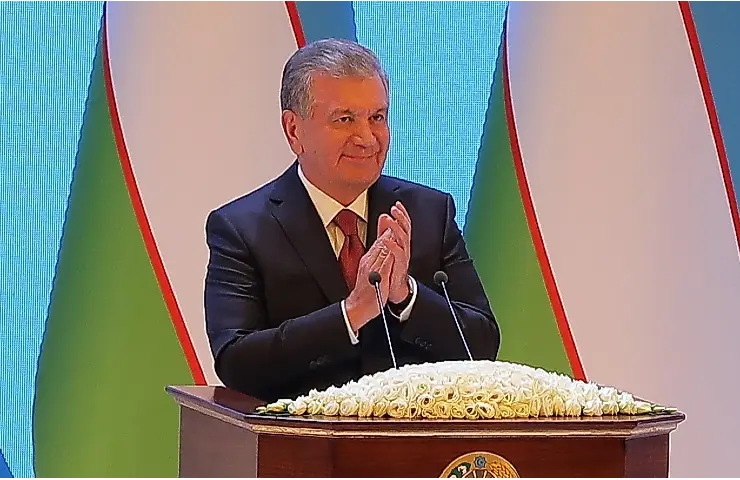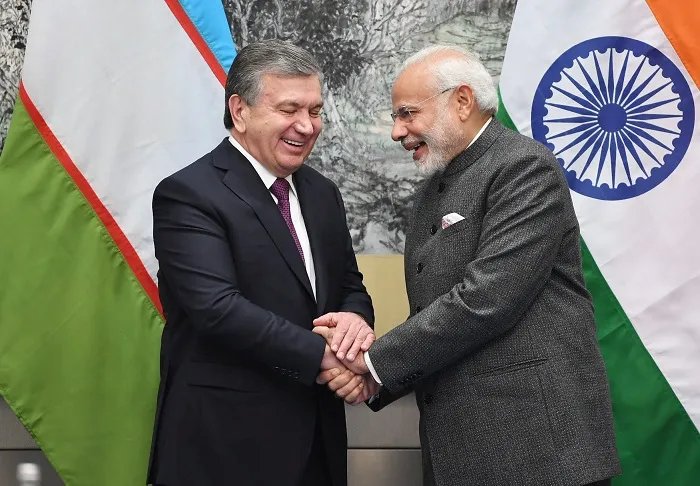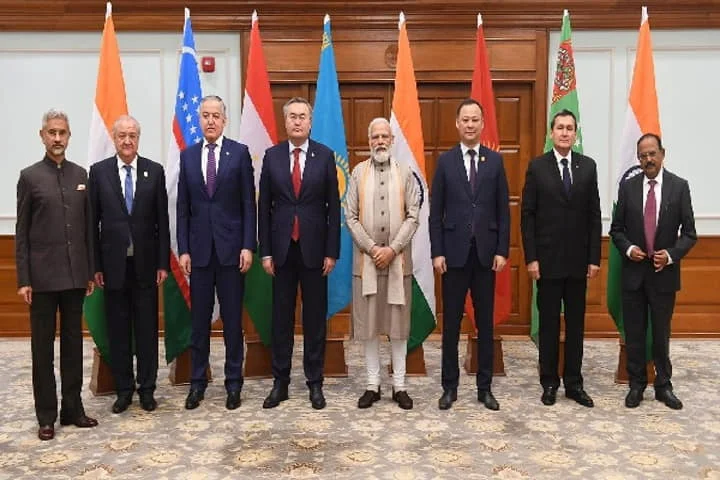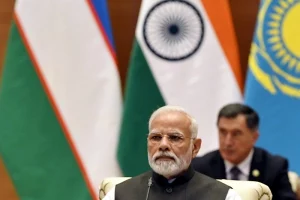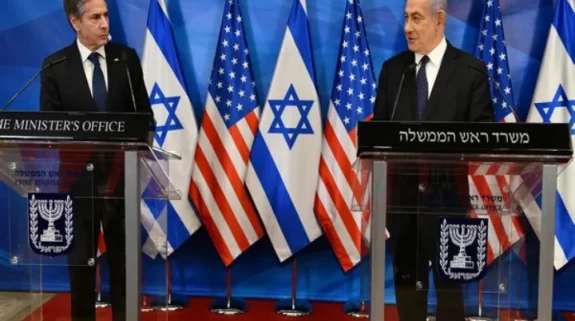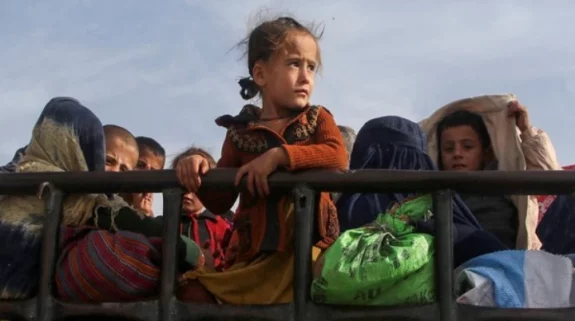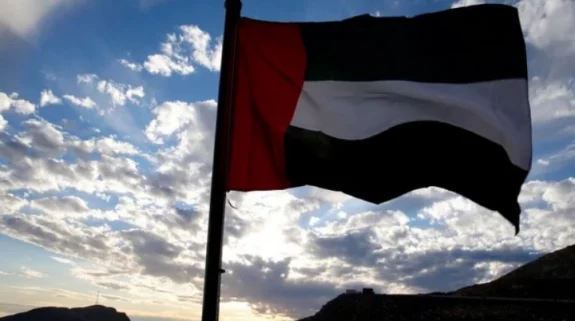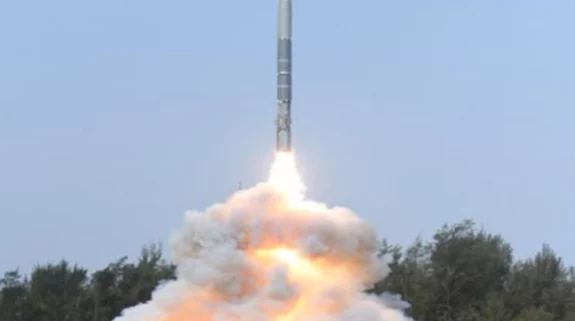The announcement of Taliban’s acting minister of Commerce and Industry, Nooruddin Azizi, seeking Kazakhstan and Russia’s participation in building a trans-Afghan railway, advances Uzbekistan’s proposal to link landlocked Central Asia with the Arabian Sea coast. This decision furthers Taliban’s visualisation of geopolitical realignment following the end of Russia-Ukraine conflict, opening new opportunities to build the railway. By inviting Kazakhstan and Russia, Taliban aims to strengthen regional connectivity via the Trans-Afghan Railway project with an aim to bring Kabul closer to major potential export markets in the Central Asian region.
First proposed by Uzbekistan in December 2018, the Trans-Afghan railway project, initially aims to extend Afghan railway network from Mazar-e-Sharif to Kabul.
Thereafter it proposes connecting with Nangarhar province, where the rail network would cross Torkham border reaching Peshawar, the sixth largest city in Pakistan.
The Islamic Emirate of Afghanistan has intensified efforts to launch the Trans-Afghan railway line connecting Termez-Mazar-e-Sharif-Kabul–Peshawar.
For more details, watch the video report below: pic.twitter.com/AhN5DAaw8z— د ریاست الوزراء اقتصادي معاونیت (@FDPM_AFG) December 21, 2022
After entering Pakistan, the goods will be offloaded and connected with the country’s domestic rail system, reaching ports of Karachi, Gwadar, and Qasim. The railway system further enables priority access to Karachi, Gwadar, and Qasim. On that note, Uzbekistan had built a 75-kilometer railway network, connecting Hairatan (at the Uzbek-Afghan border) with the city of Mazar-e-Sharif, north of Afghanistan in late 2011. But due to high operational maintenance and inadequate technical expertise, the link between Hairatan to Mazar-e-Sharif was rarely utilised. That said, currently, freight transiting from Uzbekistan to Afghanistan using land routes near the border at Termez or at Hairatan.
If successful, the Trans -Afghan Railway will have the potency to carry over 20 million tons of cargo per annum, and when operational, the time taken to transit goods from Uzbekistan to Pakistan, will be reduced from 36 days (approx.) to 3 to 5 days. The railway line will stretch to over 573 km built with a 1520 mm Russian gauge for an estimated cost to over $4.8 billion. Initially, the time frame was set for five years, with Taliban inviting Moscow and Asthana, it is yet to see if intended parties agree to finish in the estimated timeline.
To that note, on 18 July 2022 we witnessed, Tashkent formally announcing the commencement of a feasibility study along the proposed rail link. During the course we heard Kazakh President Kassym-Jomart Tokayev announcing Asthana’s readiness to assist in the railway project sharing their expertise on rolling stock and tracks.
Regional commitment or Expanding transport corridors?
The recent announcement by Nooruddin Azizi not only strengthens Asthana’s commitment towards stabilising Afghanistan, but also bolsters prospects of regional peace and stability through infrastructure development in the region. During his address to the newly appointed Ambassadors, President Kassym-Jomart Tokayev, then highlighted the importance of stable Afghanistan for regional peace, and hoped for a united state, thriving in peace internally and with its neighbours. An invitation from Taliban opens new doors for Kazakhstan to engage with partnering economies in developing Afghanistan’s infrastructure, sharing its expertise in the vital areas of energy security, transportation and agriculture. With Asthana’s assistance, Kazakhstan may prove vital in uplifting Afghanistan into a regional economy, and through its contribution in projects like Trans-Afghan Railway, potentially linking Kabul with centres of international trade.
The Trans-Afghan Railway project further provides Asthana a unique opportunity to strengthen bilateral trade relationship with Kabul giving it a unique opportunity to support local Afghan masses by making efforts to slow down the humanitarian crisis and Afghan’s economy. There is no doubt Asthana has been providing humanitarian support/aid to the Afghan people for decades, which does not impact long term and devoid of making any progress in Kazakh-Afghan relations.
Instead, the railway project is an opportunity for Asthana to bridge its relations with Kabul. Moving beyond bilateral trade Kazakhstan can establish people-to-people bonds through hard and soft infrastructure development and other technical support. Nevertheless, there has been an incremental increase in the trade relations between the countries. Last year, bilateral trade between the two was recorded to almost $1 billion, which is twice compared to the previous two years. Taking a step ahead, to strengthen economic relations and trade between the two nations, Astana played a host to the Kazakh-Afghan business forum in August, which included representatives from Afghan banks, the Ministry of Trade, Kazakh Export Company, and several Kazakh banks along with logistics companies engaging in fruitful discussions with their Afghan counterparts. According to an expert, who attended the forum, Afghan goods including agricultural products, carpets and saffron were part of exhibitions. The objective was to facilitate trade link between the two countries and expand the range of goods.
Azizi’s request to invite Asthana’s participation points towards mutual interest on technical cooperation between Kazakhstan and Afghanistan, which may prove productive for Taliban in gathering regional support. Azizi’s decision reflects Taliban’s interest in strengthening its case for international recognition with an intent to counter restrictions imposed on women’s education, violation of human rights and allegations of war crimes (particularly against marginal groups such as Hazaras) and continued political persecution of Afghans (Uzbeks & Tajiks to name a few).
For Asthana, participation in Trans Afghan Railway line project does not limit to its commitment to the Afghan community but also provides greater trade cooperation not only with Afghanistan but also Pakistan and Iran, integrating Astana into regional economy.
More specifically, technical cooperation in the Trans-Afghan Railway line project could open doors for sustained/expanded trade and investment with Afghanistan, which could provide greater access to Kazakhstan’s transport corridors, especially the Trans-Caspian International Transport Route, which it actively promotes. This will strengthen Asthana’s position as a gateway of trade between Europe and Asia.
A few days ago, #Kazakhstan submitted updated roadmap to #Azerbaijan for developing Trans-Caspian International Transport Route (TITR), also known as #MiddleCorridor. Renewed document aims to facilitate #trade & reshape regional economic growth.
Compared to Northern Corridor,… pic.twitter.com/68CMtSqb5Q
— Aybaniz Ismayilova (@AybanizIsm) August 24, 2023
Besides, Asthana’s participation will open sustained dialogues with Kabul, giving it the opportunity (necessary platform) to discuss matters of terrorism, strengthen national security by seeking any form of commitment from direct attacks by Al Qaeda factions in the region, or any other affiliate groups threatening its economic security, which has largely been hit due to western sanctions against its biggest trading partner, Russia.
An over-ambitious project?
The proposed railway line not only has the potency to redefine Uzbekistan’s status to greatly land linked but also potentially open new trade routes for the largest landlocked country in Asia, Kazakhstan. This further means greater regional economic security (not just for Uzbekistan and Kazakhstan) accessing potential markets in distant lands connecting Europe with Asia, South Asia, Southeast Asia, and North America. That said, the proposed project suffers through numerous technical, financial and topographical challenges the biggest being the allocation of finances for the implementation of this proposed railway line project. Taking note of topographical challenges in Afghanistan, logistical nightmare under harsh conditions and sustained corruption, the estimated cost will substantially increase during implementation phase.
Implementation phase
The immediate challenge during the implementation phase will arise in financing the project (estimated cost of over $4.8 billion). First proposed by Tashkent, it aims to attract finances from the U.S. International Development Finance Corporation and similar financial institutions (the World Bank and the Asian Development Bank to name a few). There are no commitments made so far. The feasibility studies are self-financed by Tashkent, though Islamabad aimed to raise funds for railway line, serious economic crisis and domestic insecurity along with a caretaker government in place will delay any progress for now. Experts from the Seifullin Kazakh Agro Technical University question Asthana’s firm commitment (possibility in the near future) whereas specialists from the Tomsk Polytechnic University & Bauman Moscow State Technical University speculate on the possibility of any financial commitment by Moscow.
On that, during the discussion with an expert from the World Bank, he argued on the context of intense in securitization (economic and human) in the region, no international or regional financial credit institutions would promise certain line of credit that to, to an entity that remain globally unrecognised. The mounting hue and cry over violence induced against marginal community and ethnic based subjugation, continues to remind global nations (over the discussions on financial commitment) even for humanitarian aid. That said, The Islamic State in 2015 vowed to target individuals working on the Trans-Afghan railway line, making a strong case against financial support rather for it.
Even then, hypothetically (assuming it receives the necessary aid) it remains undecided on the context of who will retain administrative authority over the railway line.
Challenging topography
Afghanistan has no shortage of surprises in topography. Partnering nations need to undertake rugged terrain, cliffs, deep valleys, and dry climate with limited precipitation, into account. These harsh environmental conditions may potentially delay the project in its implementation phase, forcing participating states to adjust or make alternate plans during the course.
On that note, the railway project proposes a track passing through the Salang Pass, of the Hindu Kush mountains, over an altitude of 3500 meters. If implemented, it would become one of the highest railway lines in the world. From topographic point of view, the Salang pass experiences heavy snowfall and is prone to avalanches in the peak winter season, which could temporarily halt movement of goods during the season. To construct a railway line, participating nations need to build an alternate tunnel below the mountain. This would not only increase the estimated cost, but hamper movement of goods and transport during the period. That said, topography and harsh weather conditions can seriously compromise proposed infrastructure, increase estimated time and potentially isolate local markets.
That said, in January 2022 we witnessed the Taliban approving rail route passing through Baghlan and Bamiyan, which experts (from the erstwhile Railway Authority established under the then republic government) pointed an alternate route to skip the Salang Pass and the complexities that arises from it. The alternative route (Baghlan-Bamiyan route) has been used more than often, when the Salang Pass was closed temporarily for repairs. According to the experts, this may increase the duration and develop new alternatives, challenging traditional railway planning initiatives in the future.
Operational phase
In addition to this, operational issues such as payments to land holders (depending upon the type of agreement, lease or acquisition) along the railway line, feasibility of transmission lines established across the route, and the training component for workforce, their distribution (if contributed by participating state, their numbers and designated roles & responsibilities) followed by local workforce distribution, pay and perks along with establishment of an administrative body to oversee maintenance, remains undiscussed.
Also, one of the key challenges that will most definitely appear during operational phase, is the use of gauges. The proposed railway project will be built predominantly using 1,520 mm Russian gauge enabling the railway line to connect with same broad gauge used in Uzbekistan. However, participating states need to change 1,520 mm broad gauge to 1,676 mm for the rail track along the Afghanistan-Pakistan border. This would employ significant delay (several hours) at the border as technical teams’ new tracks suiting the wheel. In addition to time, the operating cost will increase. It further requires detail deliberation on the use of gauges for smooth transport (as Uzbekistan uses the Russian broad gauge 1520mm gauge whereas Pakistan uses 1676 mm gauge). That said, during the Karzai government tenure, Kaul had opted to use the international standard of 1435 mm gauge. This could result in Taliban inviting China, which uses multiple gauges in domestic railway network and has required technical expertise. If the problem persists, (taking the note of existing delipidated state of tracks) cargo would need to be unloaded and reloaded at different border junctions.
If implemented, the railway project will significantly reduce the cost and time duration of goods transported currently through the highway between Mazar-i-Sharif and Kabul, with power cables currently extended to Kabul from Uzbekistan and Tajikistan with an intent to stretch across the region. During the discussion with an expert, if implemented the transit time will be reduced by 40%. It will further reduce the time taken for goods to travel from the Russian border (Ozinsky District of Saratov Oblast) to Karachi to 15-17 days, while from Termez to Karachi to 7-9 days. The expert further stated that the traffic would elevate trade to over 12 million.
Maintenance phase
If the proposed railway project is implemented, hypothetically, one of the most important challenges will arise on Taliban’s technical efficacy to maintain the rail project. In the light of infrastructure devoid Afghanistan, it is highly likely for the Taliban to propose joint maintenance with participating nations, which further raises inquiries on the nature of joint maintenance, manpower distribution, terms of cooperation and nomination of the lead nation and the agency for joint cooperation.
In a resource stretched and critical infrastructure devoid Afghanistan, there are three railway lines all of them in the northern region. They are all operational, but the lines do not extend to certain length, beyond the north.
Out of the three, there are two railway lines that connect Afghanistan with Turkmenistan.
One covers almost 10 km inside Afghanistan, connecting to the border town of Towrgondi, in the northern Herat province of Afghanistan. The line was built during the early 1960s and was upgraded recently (in 2018).
The second line covers a distance of 30 km inside the Afghan territory, to the Andkhoy city, of the Andkhoy District in the Faryab Province. It was operationalised in 2021.
The third railway line covers a distance of over 100-km, connecting the border city of Termez in Uzbekistan to Mazar, the fourth-largest city in Afghanistan. This will be a part of the proposed trans-Afghan project linking Uzbekistan to Pakistan. The railway line connecting Termez, crosses the Dustlik (Friendship) Bridge built in the initial years of the Soviet military campaign in Afghanistan. The line did not cover more than a few kilometres inside Afghanistan. As a result, an extension to the line was drawn, connecting Mazar-e Sharif in 2011 that served as a supply route for NATO troops, connecting Afghanistan with Europe.
The aforementioned railway line to Mazar continues to be maintained and managed by Uzbekistan Temir Yollari, an Uzbekistan’s state railway company, even after the takeover of Taliban. Months later, we witnessed Taliban complaining about Uzbeks unable to fulfil their commitments in a timely manner, witnessing dissatisfaction and possibly point of contention between Taliban and Uzbeks.
Conclusion
Taking it as a hypothesis, assuming the trans-Afghan railway project is complete, Taliban transport officials will be tasked to oversee and maintain a total line of 573 km most of which will be running through rugged terrain under harsh climatic conditions. Taliban does not have necessary technical expertise in administrating a railway line with the exiting railway (in a delipidated state) less than 150 kms, where the network travels mostly in levelled (plain areas, low lying regions) terrain. Putting aside the necessary expertise and the training platforms for Taliban officials, the cost for maintaining the upkeep of necessary equipment especially in the mountainous region is going to be enormous.
If not hindered by enormous cost, the issue of insecurity due to the presence of Islamist factions operating in the region has derailed many projects earlier and will potentially delay, if not derail. Prominently, because the proposed railway line passes through the region known to have remnants of National Resistance Front and Afghanistan Freedom Front, a group formed mainly of Afghan Special Operations Commandos, disgruntled members of the previous regime, loyalist fighters from all ethnicities (Marshal Dostum and Mohaqiq to name of few). The railway line also faces severe threat from the Taliban’s ideological rival, the Islamic State of Khorasan Province (IS-KP), which has vowed to target any individuals irrespective of identity of members of the participating states.
Despite the humongous obstacles, the grandiose projects may not be unachievable, provided a broader regional consensus can be reached on addressing the problems in an integrated framework, predicated on Afghanistan’s political stability under Taliban.
(Anant Mishra specialises on Afghanistan, where he has served three combat deployments. He was adviser to key military and civilian leaders of the Ashraf Ghani government. Views expressed are personal and exclusive to India Narrative)









